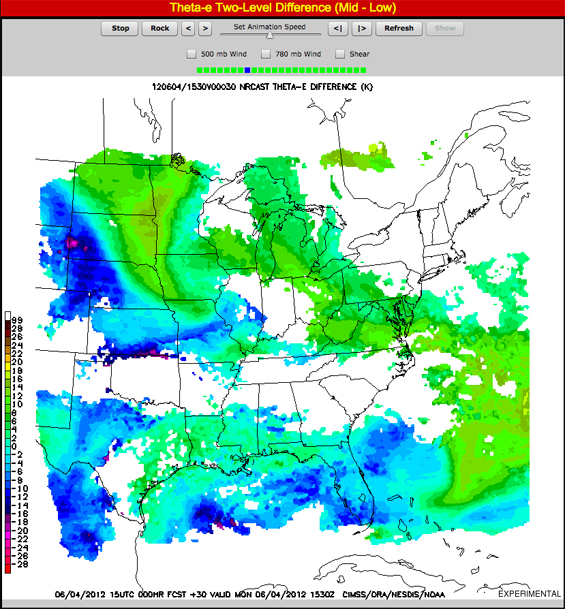“Nearcasting” Provides More Accurate Forecasts
For the past three weeks, Robert Aune (NOAA/NESDIS ASPB) and Jordan Gerth (UW-Madison CIMSS) have been participating in the National Weather Service’s Storm Prediction Center’s (SPC) Hazardous Weather Testbed (HWT) and the Aviation Weather Center’s Aviation Weather Testbed (AWT) in Norman, OK.
Aune and Gerth assisted NWS forecasters with interpreting near-casting products generated by the CIMSS GOES Sounder near-casting model.
CIMSS Convective Development Nearcasting Model (CCDNM) – Theta-e Two-Level Difference (Mid-Low)
Nearcasting, using three channels of infrared water vapor data gathered from the GOES sounder, can be used to predict severe weather outbursts 1 to 6 hours in advance. This technique fills the gap between radar nowcasts, which predict weather in the 0 – 1 hour range, and NWP forecasting models which predict weather more than 8 hours in advance. Near-casting has been found very useful in locating areas where convective storms are most likely to form or are not likely to form, greatly expanding warning times for such extreme weather events.
Data derived from nearcasting has also provided a new parameter, Convective Available Potential Energy (CAPE), which may be very valuable in predicting severe weather.
When an air mass is unstable, pressure differences can force an element of the air mass upwards, displacing air at higher altitudes. This convection usually creates vertically developed clouds, due to the rising motion, which can eventually lead to thunderstorms. It can also be created in other phenomenon, such as a cold front. CAPE is effectively the positive buoyancy of a specific bundle of air and, when measured accurately, is an indicator of atmospheric instability.
Nearcasting will increase lead time and accuracy for weather forecasts and warnings, reducing loss of life, injuries and damage to property.

